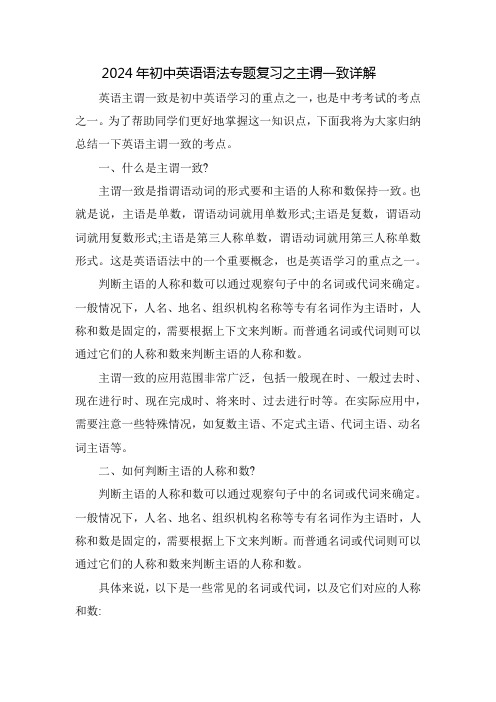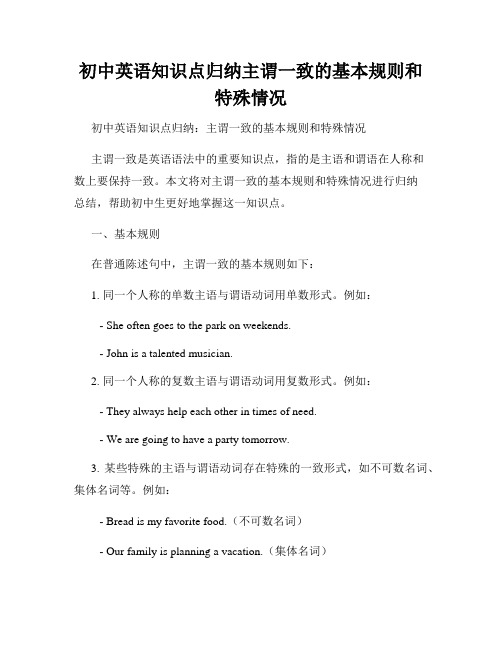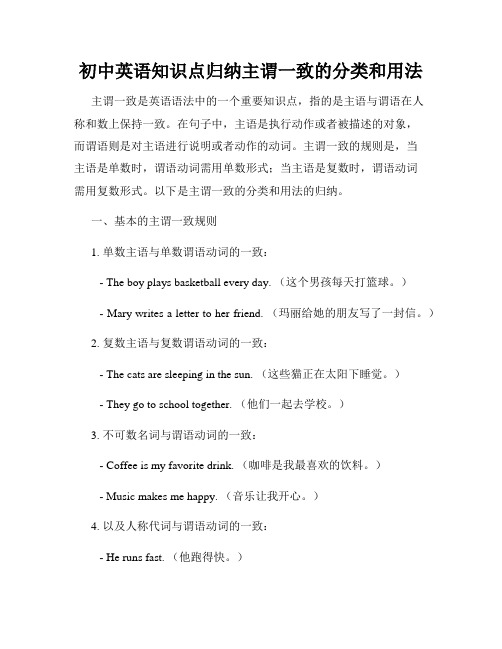初中英语语法归纳总结及主谓一致
2024年初中英语语法专题复习之主谓一致详解

2024年初中英语语法专题复习之主谓一致详解英语主谓一致是初中英语学习的重点之一,也是中考考试的考点之一。
为了帮助同学们更好地掌握这一知识点,下面我将为大家归纳总结一下英语主谓一致的考点。
一、什么是主谓一致?主谓一致是指谓语动词的形式要和主语的人称和数保持一致。
也就是说,主语是单数,谓语动词就用单数形式;主语是复数,谓语动词就用复数形式;主语是第三人称单数,谓语动词就用第三人称单数形式。
这是英语语法中的一个重要概念,也是英语学习的重点之一。
判断主语的人称和数可以通过观察句子中的名词或代词来确定。
一般情况下,人名、地名、组织机构名称等专有名词作为主语时,人称和数是固定的,需要根据上下文来判断。
而普通名词或代词则可以通过它们的人称和数来判断主语的人称和数。
主谓一致的应用范围非常广泛,包括一般现在时、一般过去时、现在进行时、现在完成时、将来时、过去进行时等。
在实际应用中,需要注意一些特殊情况,如复数主语、不定式主语、代词主语、动名词主语等。
二、如何判断主语的人称和数?判断主语的人称和数可以通过观察句子中的名词或代词来确定。
一般情况下,人名、地名、组织机构名称等专有名词作为主语时,人称和数是固定的,需要根据上下文来判断。
而普通名词或代词则可以通过它们的人称和数来判断主语的人称和数。
具体来说,以下是一些常见的名词或代词,以及它们对应的人称和数:人名:第三人称单数,如John、Mary等;第一人称复数,如We、They等。
地名:第三人称单数,如New York、Beijing等;第一人称复数,如We、They等。
组织机构名称:第三人称单数,如The White House、The Pentagon 等;第一人称复数,如We、They等。
代词:第三人称单数,如He、She、It等;第一人称复数,如We、They等。
普通名词:单数形式,如book、dog等;复数形式,如books、dogs 等。
需要注意的是,有些名词或代词在使用时会有变化,例如单数变为复数、第三人称变为第一人称等。
七年级英语知识点总结:主谓一致

七年级英语知识点总结:主谓一致七年级英语知识点总结:主谓一致在英语中,句子中的谓语动词在人称和单、复数形式上必须和主语保持一致,这就是我们通常说的“主谓一致”。
这一点看似简单,但在实际运用中却常常遇到麻烦。
一般情况下,主谓之间的一致关系由以下三个原则的支配:语法一致原则、意义一致原则和就近原则。
一、语法一致主谓一致的原则是指主语和谓语从语法形式上取得一致:主语是单数形式,谓语也采取单数形式;主语是复数形式,谓语亦采取复数形式.例如:He often helps me learn English. .My friends often help me learn English.但主语和谓语从语法形式上取得一致的问题远不只上述的那么简单,有许多方面的情况需要去具体地对待:1、不定式,动名词,以及从句作主语时应看作单数,谓语动词用单数. 例如: Reading aloud is helpful to learn English.大声朗读对学习英语是有帮助的。
What he said has been recorded .他说的话已被录音了.2、不定代词one, every, each, everybody, everyone, one of, no one, nothing, nobody, someone, somebody, either, neither, many a 等作主语或是修饰主语时应看作单数,谓语动词用单数.但none 作主语时,谓语动词既可用单数也可用复数,这要取决于说话人的看法。
例如:Neither of my sisters likes sports .我的妹妹中没人喜欢运动.Every boy and girl shos great interest in this book .每个男孩和女孩对这本书都表现出很大的兴趣.3、表示国家,机构,事件,作品等名称的专有名词作主语时应看作单数,谓语动词用单数.例如: One housand And One Nights tells people lots of interesting stories . 《一千零一夜》给人们讲了许多有趣的故事。
初中英语语法主谓一致的知识点总结

初中英语语法主谓一致的知识点总结初中英语语法主谓一致的知识点总结主谓一致一.概念:主谓一致是指:1) 语法形式上要一致,即单复数形式与谓语要一致。
2) 意义上要一致,即主语意义上的单复数要与谓语的单复数形式一致。
3) 就近原则,即谓语动词的单复形式取决于最靠近它的词语,一般来说,不可数名词用动词单数,可数名词复数用动词复数。
例如:There is much water in the thermos.但当不可数名词前有表示数量的复数名词时,谓语动词用复数形式。
例如:Ten thousand tons of coal were produced last year.二.相关知识点精讲1.并列结构作主语时谓语用复数,例如:Reading and writing are very important. 读写很重要。
注意:当主语由and连结时,如果它表示一个单一的概念,即指同一人或同一物时,谓语动词用单数,and 此时连接的两个词前只有一个冠词。
例如:The iron and steel industry is very important to our life. 钢铁工业对我们的生活有重要意义。
典型例题The League secretary and monitor ___ asked to make a speech at the meeting.A. isB. wasC. areD. were答案B. 注:先从时态上考虑。
这是过去发生的事情应用过去时,先排除A.,C。
本题易误选D,因为The League secretary andmonitor 好象是两个人,但仔细辨别,monitor 前没有the,在英语中,当一人兼数职时只在第一个职务前加定冠词。
后面的职务用and 相连。
这样本题主语为一个人,所以应选B。
2. 主谓一致中的靠近原则1)当there be 句型的主语是一系列事物时,谓语应与最邻近的主语保持一致。
初中英语知识点归纳主谓一致

初中英语知识点归纳主谓一致主谓一致是英语语法中的重要知识点,它指的是句子中的主语与谓语在人称和数方面要保持一致。
主谓一致的正确运用可以使句子结构完整,表达清晰,下面将对初中英语主谓一致的相关知识进行归纳总结。
一、第一人称和第三人称的一致1. 当主语为单数第一人称(I)时,谓语动词要用第一人称的单数形式。
例:I am a student.(我是一个学生。
)2. 当主语为单数或复数的第三人称(he、she、it、they)时,谓语动词要用第三人称的单数形式。
例:She works in a hospital.(她在医院工作。
)They like playing football.(他们喜欢踢足球。
)二、主谓一致的特殊情况1. 当主语为复数形式时,谓语动词要用复数形式。
例:We are students.(我们是学生。
)They are teachers.(他们是老师。
)2. 当主语为不可数名词时,谓语动词要用单数形式。
例:Water is important for our health.(水对我们的健康很重要。
)Time flies.(时光飞逝。
)三、连接词和主谓一致当句子中出现连接词“or”、“nor”时,谓语动词要与最近的主语保持一致。
例:Tom or his friends are going to the party.(汤姆或者他的朋友们要去参加聚会。
)四、不定代词和主谓一致1. 当主语为不定代词“each”、“every”、“either”、“neither”、“everyone”、“somebody”等时,谓语动词要用第三人称的单数形式。
例:Each boy has his own dream.(每个男孩都有自己的梦想。
)Everybody loves the beautiful sunset.(每个人都喜爱美丽的日落。
)2. 当主语为不定代词“some”、“many”、“a lot of”、“most of”等时,谓语动词根据主语而定。
初中英语知识点归纳主谓一致的基本规则和特殊情况

初中英语知识点归纳主谓一致的基本规则和特殊情况初中英语知识点归纳:主谓一致的基本规则和特殊情况主谓一致是英语语法中的重要知识点,指的是主语和谓语在人称和数上要保持一致。
本文将对主谓一致的基本规则和特殊情况进行归纳总结,帮助初中生更好地掌握这一知识点。
一、基本规则在普通陈述句中,主谓一致的基本规则如下:1. 同一个人称的单数主语与谓语动词用单数形式。
例如:- She often goes to the park on weekends.- John is a talented musician.2. 同一个人称的复数主语与谓语动词用复数形式。
例如:- They always help each other in times of need.- We are going to have a party tomorrow.3. 某些特殊的主语与谓语动词存在特殊的一致形式,如不可数名词、集体名词等。
例如:- Bread is my favorite food.(不可数名词)- Our family is planning a vacation.(集体名词)4. 当主语由连接词"And"连接时,如果主语是同一个人称的名词,谓语动词用复数形式;如果主语是不同人称的名词,则谓语动词用较靠近的那个名词的人称形式。
例如:- Tom and Mary are good friends.(同一人称)- Tom and I are going shopping.(不同人称)二、特殊情况除了上述基本规则外,主谓一致在一些特殊情况下需要特别注意。
1. 不定代词作主语时,谓语动词的单复数形式根据不定代词所指代的含义来决定。
例如:- Everyone is responsible for protecting the environment.- Some students have already finished their homework.2. 以each、every、either、neither开头的句子,谓语动词一般用单数形式。
初中英语知识点归纳主谓一致的分类和用法

初中英语知识点归纳主谓一致的分类和用法主谓一致是英语语法中的一个重要知识点,指的是主语与谓语在人称和数上保持一致。
在句子中,主语是执行动作或者被描述的对象,而谓语则是对主语进行说明或者动作的动词。
主谓一致的规则是,当主语是单数时,谓语动词需用单数形式;当主语是复数时,谓语动词需用复数形式。
以下是主谓一致的分类和用法的归纳。
一、基本的主谓一致规则1. 单数主语与单数谓语动词的一致:- The boy plays basketball every day. (这个男孩每天打篮球。
)- Mary writes a letter to her friend. (玛丽给她的朋友写了一封信。
)2. 复数主语与复数谓语动词的一致:- The cats are sleeping in the sun. (这些猫正在太阳下睡觉。
)- They go to school together. (他们一起去学校。
)3. 不可数名词与谓语动词的一致:- Coffee is my favorite drink. (咖啡是我最喜欢的饮料。
)- Music makes me happy. (音乐让我开心。
)4. 以及人称代词与谓语动词的一致:- He runs fast. (他跑得快。
)- We are studying English. (我们正在学习英语。
)二、特殊情况的主谓一致规则1. 当主语是由“each”、“every”、“everyone”、“everybody”、“either”、“neither”等引导的词时,用单数谓语动词:- Every student needs to study hard. (每个学生都需要努力学习。
) - Neither of the boys is interested in football. (这两个男孩都对足球不感兴趣。
)2. 当主语是由“some”或“any”等修饰的复数名词时,根据后面的名词的属性决定谓语动词的单复数:- Some of the apples are ripe. (一些苹果已经熟了。
初中英语--主谓一致知识点
初中英语--主谓一致知识点定义:主谓一致指句子的谓语动词与其主语在人称和数上必须保持一致。
主谓一致要遵循三个基本原则,即语法一致原则、意义一致原则和就近一致原则。
一、语法一致语法一致指主语和谓语在语法形式上保持一致,即主语是单数形式时,谓语动词也用单数形式;主语是复数形式时,谓语动词也用复数形式。
1.单数可数名词或代词单数、不可数名词作主语时,谓语动词用单数形式;可数名词复数或代词复数作主语时,谓语动词用复数形式。
如:He works at a radio station.他在广播电台工作。
The manager is going to take a dinner party tonight.那位经理今晚将要参加晚宴。
In fact, the Internet has changed the way we communicate.实际上,网络已经改变了我们的交流方式。
2.由and或both... and...连接的并列成分作主语时,谓语动词用复数形式。
如:Mr. Black and Mrs. Black have a son called Mike.布莱克夫妇有个儿子叫迈克。
3.用“one,every one, each one, any one, each, either,neither等+of+复数名词”作主语时,谓语动词用单数形式。
如:Each one of the children is eager to go home.每个孩子都想回家。
4.不定代词either,neither,each, one,the other, another,someone,somebody,something,anyone, anything, everyone,everybody,everything,nothing,no one.等作主语时,谓语动词常用单数。
如:Everyone is good at something, but some people are truly talented.每个人都擅长某件事,但有些人真的很有天赋。
英语九年级语法知识点
英语九年级语法知识点一、主谓一致主谓一致是指主语与谓语在人称和数上保持一致。
具体规则如下:1. 一般情况下,主谓一致遵循以下原则:a. 单数主语用单数谓语动词,如:The dog barks.(这只狗叫唤。
)b. 复数主语用复数谓语动词,如:The dogs bark.(这些狗叫唤。
)2. 当主语是以each,every,either,neither,one of等词开头时,谓语动词要用单数形式,如:Each student has a book.(每个学生都有一本书。
)3. 当主语是复数且由and连接的两个或两个以上的部分构成时,谓语动词要用复数形式,如:Tom and Lisa work together.(汤姆和丽莎一起工作。
)4. 当主语是并列名词,中间有or,nor,either...or,neither...nor连接时,谓语动词与靠近的主语保持一致,如:Neither David nor his friends are coming to the party.(大卫和他的朋友都不来参加派对。
)二、时态时态是表示动作或状态发生时间的一种语法形式。
常见的英语时态有以下几种:1. 现在时:表示当前的动作或状态。
a. 现在简单时:经常性或习惯性动作,或者现在的真理、规律等。
如:I play basketball every Sunday.(我每个星期天打篮球。
)b. 现在进行时:表示目前正在进行的动作。
如:They are watching a movie.(他们正在看电影。
)c. 现在完成时:表示过去发生但对现在产生影响的动作。
如:She has already done her homework.(她已经完成作业了。
)2. 过去时:表示过去的动作或状态。
a. 过去简单时:表示在过去某个时间发生的动作。
如:I finished my project last night.(昨晚我完成了我的项目。
初中英语知识点归纳主谓一致的原则和例子
初中英语知识点归纳主谓一致的原则和例子主谓一致是英语语法中的一个重要知识点。
它指的是句子中的主语和谓语在人称和数上要保持一致。
在掌握了主谓一致的原则和规则后,我们可以避免在句子中出现不一致的错误,从而提高写作和口语表达的准确性。
本文将对主谓一致的原则进行归纳,并提供相应的例子以便更好地理解。
一、主谓一致的原则:1. 单数主语要用单数谓语动词,复数主语要用复数谓语动词。
2. 当主语是第三人称单数时,谓语动词要加上“-s”或“-es”。
3. 以“-y”结尾的动词,当主语是第三人称单数时,要把“-y”变为“-ies”。
4. 当主语由两个或多个名词或代词连接时,谓语动词要与最近的一个名词或代词保持一致。
二、主谓一致的例子:1. 单数主语和单数谓语动词:- Tom runs every morning. (汤姆每天早上跑步。
)- The bird sings a beautiful song.(小鸟唱着一首美妙的歌。
)2. 复数主语和复数谓语动词:- They play basketball every weekend.(他们每个周末打篮球。
)- The students are studying in the classroom.(学生们正在教室里学习。
)3. 第三人称单数主语和加“-s”或“-es”的谓语动词:- She writes a letter to her friend.(她给她的朋友写了封信。
)- The dog barks at the stranger.(狗对着陌生人叫。
)4. 以“-y”结尾的动词,当主语是第三人称单数时要变为“-ies”:- The baby cries when he is hungry.(宝宝饿了的时候会哭。
)- The butterfly flies above the flowers.(蝴蝶在花丛上方飞翔。
)5. 由两个或多个名词或代词连接的主语,谓语动词要与最近的一个名词或代词保持一致:- Neither the cat nor the dog is at home.(猫和狗都不在家。
初中英语知识点归纳主谓一致的用法
初中英语知识点归纳主谓一致的用法主谓一致是英语语法中的重要知识点之一。
它指的是主语和谓语在人称和数方面保持一致。
正确运用主谓一致规则可以使句子更加准确、清晰,并避免语法错误。
本文将对初中英语中主谓一致的用法进行归纳总结。
一、单数主语与单数谓语动词的一致当主语为单数形式时,谓语动词也要使用单数形式。
例如:1. The boy plays basketball every day.(这个男孩每天打篮球。
)2. My sister enjoys reading novels.(我姐姐喜欢读小说。
)3. The cat is sleeping on the sofa.(猫正睡在沙发上。
)二、复数主语与复数谓语动词的一致当主语为复数形式时,谓语动词也要使用复数形式。
例如:1. They watch TV every evening.(他们每天晚上看电视。
)2. The students are studying in the classroom.(学生们正在教室里学习。
)3. Dogs are good companions.(狗是好伴侣。
)三、以及(as well as)、和(and)、与(with)等连接多个名词作主语时的一致当以及(as well as)、和(and)、与(with)等词连接多个名词作主语时,谓语动词的单复数形式取决于离它最近的名词。
例如:1. Tom as well as his friends is going to the party.(汤姆和他的朋友们都要去参加聚会。
)2. The teacher and students are discussing the homework.(老师和学生们正在讨论作业。
)3. The girl with her parents is visiting the museum.(这个女孩和她的父母正在参观博物馆。
)四、以each、every、everyone、everybody、either、neither等开头时的一致当句子以each、every、everyone、everybody、either、neither等词开头时,谓语动词要使用单数形式。
- 1、下载文档前请自行甄别文档内容的完整性,平台不提供额外的编辑、内容补充、找答案等附加服务。
- 2、"仅部分预览"的文档,不可在线预览部分如存在完整性等问题,可反馈申请退款(可完整预览的文档不适用该条件!)。
- 3、如文档侵犯您的权益,请联系客服反馈,我们会尽快为您处理(人工客服工作时间:9:00-18:30)。
初中英语语法归纳总结及主谓一致语法归纳总结一. 词类英语词类分十种:名词、形容词、代词、数词、冠词、动词、副词、介词、连词、感叹词。
1. 名词(n.):表示人、事物、地点或抽象概念的名称。
例:boy, morning, bag, home, class, orange.2. 代词(pron.):主要用来代替名词。
例:who, she, you, it .3. 形容词(adj..):表示人或事物的性质或特征。
例:good, right, white .4. 数词(num.):表示数目或事物的顺序。
例:one, two, three, first, second, third, fourth.5. 动词(v.):表示动作或状态。
例:am, is,are,have,see .6. 副词(adv.):修饰动词、形容词或其他副词,说明时间、地点、程度等。
例:now, very, here, often, quietly, slowly.7. 冠词(art..):用在名词前,帮助说明名词。
例:a, an, the.8. 介词(prep.):表示它后面的名词或代词与其他句子成分的关系。
例in, on, from, above, behind.9. 连词(conj.):用来连接词、短语或句子。
例and, but, before .10. 感叹词(interj..):表示喜、怒、哀、乐等感情。
例:oh, well, hi, hello.二. 句子成分英语句子成分分为七种:主语、谓语、宾语、定语、状语、表语、宾语补足语。
1. 主语是句子所要说的人或事物,回答是“谁”或者“什么”。
通常用名词或代词担任。
例:I’m Miss Green.我是格林小姐。
2. 谓语动词说明主语的动作或状态,回答“做(什么)”。
主要由动词担任。
例:Jack cleans the room every day. 杰克每天打扫房间。
3. 表语在系动词之后,说明主语的身份或特征,回答是“什么”或者“怎么样”。
通常由名词、代词或形容词担任。
例:My name is Ping ping. 我的名字叫萍萍。
4. 宾语表示及物动词的对象或结果,回答做的是“什么”。
通常由名词或代词担任。
例:He can spell the word. 他能拼这个词。
有些及物动词带有两个宾语,一个指物,一个指人。
指物的叫直接宾语,指人的叫间接宾语。
间接宾语一般放在直接宾语的前面。
例:He wrote me a letter. 他给我写了一封信。
有时可把介词to或for加在间接宾语前构成短语,放在直接宾语后面,来强调间接宾语。
例:He wrote a letter to me. 他给我写了一封信。
5. 定语修饰名词或代词,通常由形容词、代词、数词等担任。
例:Shanghai is a big city. 上海是个大城市。
6. 状语用来修饰动词、形容词、副词,通常由副词担任。
例:He works hard. 他工作努力。
7. 宾语补足语用来说明宾语怎么样或干什么,通常由形容词或动词充当。
例:They usually keep their classroom clean. 他们通常让教室保持清洁。
The teacher wanted me to learn French all by myself. 老师要我自学法语。
注意:同位语通常紧跟在名词、代词后面,进一步说明它的情况。
例:Where is your classmate Tom ? 你的同学汤姆在哪里?三. 英语中的五种基本句型1. 基本句型一:SV(主+谓)谓语通常是不及物动词。
例:The moon rose. 月亮升起了。
What he said does not matter. 他所讲的没有什么关系。
2. 基本句型二:SVP(主+谓+表)此句型的句子有一个共同的特点:句子谓语动词都不能表达一个完整的意思,必须加上一个表明主语身份或状态的表语构成复合谓语,才能表达完整的意思。
这类动词叫做连系动词。
系动词分两类:be, look, keep, seem等属一类,表示情况;get, grow, become, turn, stay, remain等属另一类,表示变化。
另外感官动词如sound, smell, listen, taste等用法同be动词。
be 本身没有什么意义,只起连系主语和表语的作用。
其它系动词仍保持其部分词义。
例:This is an English-Chinese dictionary. 这是本英汉辞典。
The dinner smells good. 午餐的气味很好。
3. 基本句型三:SVO(主+谓+宾)此句型句子的共同特点是:谓语动词都具有实义,都是主语产生的动作,但不能表达完整的意思,必须跟有一个宾语,即动作的承受者,才能使意思完整。
这类动词叫做及物动词。
例:He has refused to help them. 他拒绝帮他们的忙。
They ate what was left over. 他们吃了剩饭。
4. 基本句型四:SV O间O直(主+谓+间宾+直宾)此句型的句子有一个共同特点:谓语动词必须跟有两个宾语才能表达完整的意思。
这两个宾语一个是动作的直接承受者,另一个是动作的间接承受者。
通常这一间接承受者用一个介词来连接,当动作的间接承受者在动作的直接承受者之前时,这一介词往往被省略。
例:He brought you a dictionary. 他给你买了一本字典。
I told him that the bus was late. 我告诉他汽车晚点了。
5.基本句型五:SVOC(主+谓+宾+宾补)此句型的句子的共同特点是:动词虽然是及物动词,但是只跟一个宾语还不能表达完整的意思,必须加上一个补充成分来补足宾语,才能使意思完整。
例:They painted the door green. 他们把门漆成绿色。
I saw them getting on the bus. 我看见他们上了那辆公共汽车。
但常用的英语句子并不都像基本句型这样简短,这些句子除了基本句型的成分不变外,通常是在这些成分的前面或后面增加一些修饰语而加以扩大。
这些修饰语可以是单词(主要是形容词、副词和数词),也可以是各种类型的短语(主要是介词短语、不定式短语和分词短语)。
下面以基本句型五为例:We found the hall full. 我们发现礼堂坐满了。
We found the great hall full of students and teachers. 我们发现大礼堂坐满了学生和教师。
We found the great hall full of students and teachers listening to an important report.我们发现大礼堂坐满了学生和教师,在听一个重要报告。
We found the great hall full of students and teachers listening to an important report made by a comrade fromthe People's Daily on current affairs in East Europe.我们发现大礼堂坐满了学生和教师,在听人民日报的一位同志作有关东欧局势的重要报告。
主谓一致定义:在英语句子里,谓语受主语支配,其动词必须和主语在人称和数上保持一致,这就叫主谓一致。
根据主谓语之间的规律大致可归纳为三个原则,即语法一致、逻辑意义一致和就近一致原则。
一、语法一致语法上一致就是谓语动词和主语在单、复数形式上保持一致。
1. 以单数名词或代词、动词不定式短语、动名词短语或从句等表示抽象意义的单词或者短语作主语时,谓语动词一般用单数形式;主语表示复数含义时,谓语动词用复数形式。
2. 由连接词and或both …… and连接起来的合成主语后面,要用复数形式的谓语动词。
若and所连接的两个词是指同一个人或物时,它后面的谓语动词就应用单数形式。
【注意】the teacher and father 那位既是教师又是父亲的人(一个人,谓语动词用单数)the teacher and the father 那位教师和那位父亲(两个人,谓语动词用复数)3. 主语为单数名词或代词,尽管后面跟有with,together with,except,but,like,as well as,rather than,more than,no less than,besides,including等引起的短语,谓语动词仍用单数形式;若主语为复数,谓语用复数形式。
例:Mr Green, together with his wife and children, has come to China.4. either,neither,each,every 或no +单数名词和由some,any,no,every构成的复合不定代词,都作单数看待。
例:Each of us has a new book.Everything around us is matter.5. 在定语从句时,关系代词that,who,which等作主语时,其谓语动词的数应与句中先行词的数一致。
6. 若集体名词指的是整个集体,它的谓语动词用单数;若它指集体的成员,其谓语动词就用复数形式。
这些词有family,class,crowd,committee,population,audience等。
【注意】people,police,cattle等名词一般都用作复数。
例:The police are looking for the lost child.7. 由“a lot of,lots of,plenty of,the rest of,the majority of + 名词”构成的短语以及由“分数或百分数+名词”构成的短语作主语,其谓语动词的数要根据短语中后面名词的数而定。
【注意】a number of“许多”,作定语修饰复数名词,谓语用复数;the number of“……的数量”,主语是number,谓语用单数。
8. 在倒装句中,谓语动词的数应与其后的主语一致。
二、逻辑意义一致逻辑意义一致就是谓语动词的数必须和主语的意义一致(因有时主语形式为单数,但意义为复数;有时形式为复数,但意义为单数)。
1. what,who,which,any,more,all等代词可以是单数,也可是复数,主要靠意思来决定。
2. 表示“时间、重量、长度、价值”等的名词的复数作主语时,谓语动词通常用单数形式,这是由于作主语的名词在概念上是一个整体。
